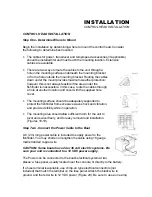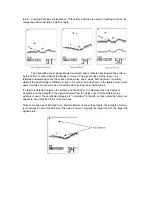
WHAT YOU SEE ON-SCREEN
The first thing you may
notice about the LCR W unit is
the high resolution screen LCD
display. The LCD display uses
super-twist technology, for
maximum viewability and is
ruggedized for tough shock and
vibration endurance. The
display can operate at
temperatures more extreme
than you are likely to encounter.
There are two basic
screen layouts for the LCR W.
Figure A shows the default
screen layout which does not include temperature and speed readings. If you have purchased the
temperature and speed accessory and it is installed, the screen layout will be slightly different as
shown in Figure B.
The number of vertical pixels (picture elements or dots) in
a given depth range determines the display resolution, or ability to
differentiate targets close to the bottom or other targets. The LCR
W is capable of distinguishing between targets only 6 inches
apart, and show fish within 6 inches of the bottom.
On all screens the horizontal line at the top of the display
is the "Zero" line. This represents the surface of the water. The
"Zero" line will always have a gap which moves as the screen
updates. This gap lets you know that the display is updating
even if the bottom terrain remains the same or is not visible on
the selected depth range. The farthest right column of information
is the most recent information, and it shows what is directly under
your boat.
At power-up, the LCR W locates
the bottom and adjusts the depth range to
a setting most appropriate for that depth.
The bottom will be usually shown about 2/3
of the way down the display. The Structure
ID T"^ depiction of the bottom will vary in
appearance depending on the bottom
terrain. If the bottom is very hard and
smooth, the bottom depiction will be narrow
and dense. If the bottom is mud or soft
sand, the bottom depiction will be thick and
less dense. This indicates that much of the
sonar signal is absorbed by the soft
bottom. If the bottom is rugged and varying,
such as a rocky bottom, the depiction will
be textured and vary in density. Structure,
such as submerged trees or brush, or other objects are clearly displayed above the solid bottom






















